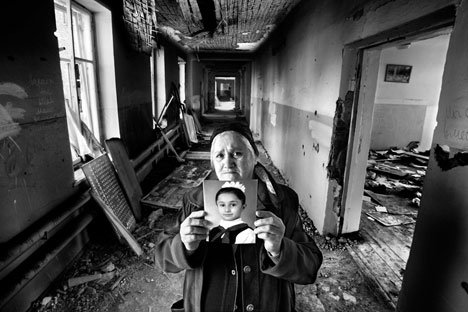
A total of 1,116 people were taken hostage at Beslan School No. 1 on Sept. 1, 2004. Of them, 333 were killed, including 186 children. Source: Getty Images / Fotobank
On the afternoon of Sunday, Aug. 31, I sat in my kitchen editing a story to run the following day. My 11-year-old daughter, K, came up behind me, reading over my shoulder, and the words she read were: “Ever year, Rita Sidakova puts a black mourning band on her head and slowly walks the familiar road that her daughter used to take to school every day. She walks into the school gym destroyed by explosions and fire. And time stops for her. She can stand there a day, two days, without food and water, just like her nine-year-old daughter, who spent the last hours of her life here, with terrorists' rifles pointing at her and the other hostages.”
“Mama,” K asked, with a little trepidation in her voice, “What is that story about?”
It was, of course, about the terrorist attack on Beslan School No.1, which took place from Sept. 1-3, 2004. K was about 18 months old then, and although I had been completely horrified by the attack at the time, it happened in the days before I looked at the pictures of the children who died, at the faces of the girls framed by long braids and white bows, and saw the faces of my own daughters. Now as I studied the text, I could barely continue reading, knowing that the next morning my own nine-year-old would get up, put on her school uniform and look very much like those pictures from Beslan.
I had never told K about Beslan. There had never been any reason to. But I also kept the news from her about the school shooting in Newtown, Connecticut, which took place in December 2012. I was fortunate that, living abroad, it was easy to avoid the 24/7 coverage of that horrific attack on a school.
I didn’t tell her about Newtown because I wanted her to believe that school was a safe place. I wanted to continue to believe this myself. Starting at the age of five or six, children spend more waking hours at school than at home. We as parents have to believe that the people responsible for them there are trustworthy, that the environment is safe. Of course we want our children to get a good education, to have friends, to reap all the benefits of school – but primarily, we want them to spend their days somewhere we don’t have to worry about their security.
But at some point, children understand that the world is not safe. Perhaps my daughters have been confronted with this realization earlier than some because newspapers are an integral part of our life and our daily routine.
When, during coverage of the Haiti earthquake in 2010, the Washington Post put a large photo on the front page of an emergency services worker carrying a child who was either severely injured or dead, and that front page ended up on my kitchen table, I had to answer questions about that tragedy – why it happened, how many people had died, how many of them were children.
During coverage of the 10th anniversary of 9/11, I had to answer the same questions about that event. And although the “why” of a terrorist attack is harder to explain than the “why” of an earthquake, the message is the same – scary, unpredictable things happen that can change your life instantly.
I told K the story of Beslan. I tried my best to explain why it happened, and to explain also that much of the “why” we will never know. She asked what was being done now to make sure nothing like that ever happened again.
I told her that there were now guards in schools, and on the first day of school in particular, the police presence is higher on the streets, and around schools. But I also told her that one of the features of terrorists is that they are not rational actors, that their plans are difficult to predict. I don’t want her to be afraid, but I also want her to be aware that no matter the best intentions, tragedies still occur.
Learning about 9/11 didn’t make K afraid of getting on an airplane, and learning about Beslan didn’t make her afraid to go to school. Maybe I got lucky and picked the right moment to talk to her about these things.
Maybe she would have reacted the same way had I told her earlier. Maybe my words didn’t sink in at all. But my hope is that the lesson she will take away – 10 years after that tragic event – is that no matter what terrible things happen, life goes on. People are resilient, even in the face of the most awful things imaginable. If the parents of Beslan can survive, our everyday minor tragedies are certainly bearable.
All rights reserved by Rossiyskaya Gazeta.
Subscribe
to our newsletter!
Get the week's best stories straight to your inbox